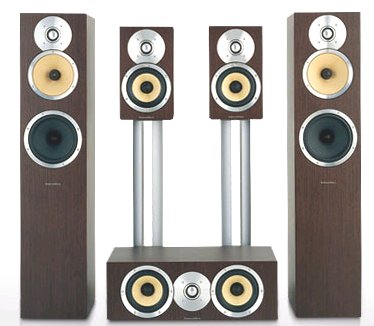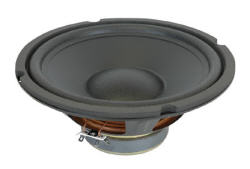
 |
|
Loudspeakers - Introduction An essential component for enjoying full movie sound from DVD-Video or 5.1 surround-sound from HDTV programs or listening to optical Disc, vinyl records or other music selections, loudspeakers may be the most important part of your home listening experience. Speakers come in all sizes and shapes from "bookshelf" to "power-tower", and all kinds of configurations, from two-channel stereo to multiple-channel surround-sound, and are made from all kinds of materials, from paper to kevlar. You do not have to spend a fortune to get good speakers but you easily could. A couple of hundred dollars could get you a good bookshelf set or you could spend $10,000 or more for a high-end floor-standing tower. Surround speakers 
A loudspeaker set from the same manufacturer's line saves you the trouble of matching separate speakers. Size has nothing to do with performance. Magnetically shielded speakers are a good idea for home theater setups because the speaker magnets could interfere with the television picture if placed too close. The number one task of the loudspeaker is to move air, but do it in such a way as to reproduce, as close as possible, the original audio performance. Loudspeaker manufacturers have worked for decades attempting to create better and better speakers by using various techniques and materials to achieve better performance. In the 1960s, most stereo speakers had paper cones. Today you can find cones made of polypropylene, kevlar (yes, the same material in bullet-proof vests) and even more exotic materials.  In prior decades the speaker enclosures were made of wood, where today you find all kinds of wood to match your decor but also metal and composites. Choosing which loudspeaker to buy With so many choices today, it is difficult to decide which loudspeakers you should get. However, there are many ways to narrow down the contenders. You may be tempted to buy loudspeakers based on a number of reasons, all of which are WRONG! Namely, how they look, how much they cost, how big they are, who manufactured them (brand loyalty), technical claims in advertising, or a so-called "expert" recommendation. The number one factor SHOULD be, how they SOUND to YOU. By doing side by side comparisons, using music of your choosing, and preferably in YOUR listening environment, you can determine the best sounding speakers. Close your eyes while listening to the music and do not let any other factor sway you such as looks. Try to determine which speakers sound best. Only then can you go to the next step, and choose colors, materials, price, brand or design. After all, if you are going to sink hundreds or even thousands of dollars into loudspeakers, you want them to sound excellent for years and years to come. Your decor may change over time but you want that audio quality to remain a constant. Factors to consider Your amplifier or receiver should be compatible with your speakers. You do not want to buy speakers which your amp cannot drive to their full potential. So match your loudspeakers to the rest of your system. Consider the speakers' sensitivity and load impedence. 8 ohm speakers need to be driven by an amp with 8 ohm capability. Check the specifications of each to be sure. Generally speaking, a company which designs, makes and sells ONLY loudspeakers is a better choice than those who sell other electronics as well as speakers. The high-end loudspeaker companies have an almost obsessive dedication to the art of loudspeaker design. Their products superior performance often reflects this commitment. Loudspeakers: Loudspeaker suppliers:  • Home Theater Audio/Video Receiver Guide • Surround Sound Formats Speaker Definitions Ampere The unit of measure for current or electrical 'flow' through a circuit. It is commonly abbreviated as 'amp' and should not be confused with the word 'amplifier', which is also commonly abbreviated as 'amp'. Built-in Crossovers Often used to keep
high-frequencies from reaching a subwoofer, a low-pass crossover
allows only frequencies below the crossover point to be amplified. Efficiency or Sensitivity An efficiency or
sensitivity rating tells you how effectively a speaker converts
power into sound. The higher the number, the more efficient the
speaker and the louder it will play with the same input power. An
efficient speaker helps you maximize your available
power. Frequency Response The range of frequencies the speaker will reproduce (lowest frequency to the highest). The wider the range, the better. Optimal is 20 - 20,000 Hz, the range of human hearing. Midrange Speaker A tweeter-less speaker (ranging in size from 3-1/2" to 6-3/4") dedicated to the reproduction of midrange frequencies. They are used in systems in which the low, midrange, and high frequencies are amplified separately. Ohm The unit of measurement for impedance. It tells you how much a device will resist the flow of current. If you take two signals of exactly the same strength and send one to a 4-ohm speaker and the other to an 8-ohm speaker, twice as much current will flow through the 4-ohm speaker. In other words, the 8-ohm speaker will require twice as much power (wattage) to play at the same volume. RMS Power vs. Peak Power The amount of continuous power, measured in watts, that an amplifier produces is called RMS power. The higher the RMS figure, the louder and cleaner your music sounds. When choosing an amplifier, the RMS rating is the power rating you should pay most attention to. Also, keep in mind that some manufacturers calculate the RMS power ratings of their amplifiers at different input voltages. For example, an amplifier rated at 100 watts RMS at 12 volts can produce considerably more power than an amp rated at 100 watts RMS at the more typical 14.4 volts. Stereo manufacturers often display peak power ratings on the face of their products. The peak power rating tells you the maximum wattage an amplifier can deliver as a brief burst during a musical peak, like a dramatic drum accent. The RMS figure is more significant. Signal-to-Noise Ratio Measured in decibels (dB), this measurement compares the strength of the desired signal (music) to the level of background noise. A higher value indicates less background noise. Total Harmonic Distortion (THD) Amount of change in harmonic content of the signal as it is amplified. A lower figure indicates less change and a more accurate amp. THD below 0.10% is inaudible. Tri-Way Output Sometimes called Dual Mode, this setup powers a pair of stereo speakers and one subwoofer simultaneously from the outputs of a single 2-channel amplifier. It's an affordable way to drive a subwoofer. It requires an external Tri-Way adaptor that is connected in line between your amplifier and your speakers. Tweeter High frequencies are reproduced by the tweeter, the small speaker. Cone tweeters are efficient and the most economical. Dome tweeters, the type found in most home speakers, sound smoother and more accurate. Some domes are made of metals like titanium for extended high frequency response. Others are made of a fine cloth like silk for a smoother sound. Some are made from a combination of materials. Voice coil The voice coil is the coil of wire in a loudspeaker that creates a magnetic field. With the help of other speaker components, the voice coil converts electrical signals into mechanical energy which is used to produce sound. The voice coil former is the part of the speaker around which the voice coil is wound. Many speakers offer a heat-resistant voice coil to prolong speaker life. Woofer Bass and lower midrange frequencies are reproduced by the woofer, the large speaker. To operate efficiently, a cone should be made of material that is stiff, yet lightweight. Cones made of polypropylene, or poly mixed with other materials, provide excellent sound, and stand up to heat, cold and moisture. Paper cones treated for moisture resistance also do a great job, and are usually very efficient.
|
COLUMBIA ISA
Empowering consumers thru
information
Learn about the various audio formats:
Audio
formats
Learn about audio features:
Audio
features
• How to hookup Surround Sound for Netflix, Hulu
• Surround Sound for TV Streaming
• Speaker setup surround sound
see also:
Audio Video Connections and cables
Cable Connections Diagrams
Video Connections Diagrams
Cable TV, Satellite TV, OTA Tuners Receivers
Cable TV, Hookup, Converters
See over 100 Hookup Diagrams
How do I know a TV is HDTV?
Most Popular HDTV